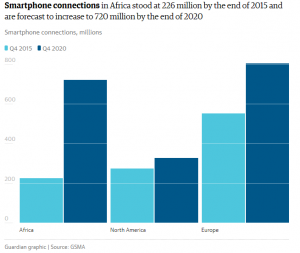The recent economic literature questions the impact of the third industrial revolution – characterized by the penetration of computers, the Internet and mobile telephony – on labour productivity and employment. Based on this literature, this note provides an overview of the digital revolution prospects for in terms of job creation in sub-Saharan Africa.
It is still too early to assess the contribution of the Internet to long-term growth in sub-Saharan Africa (SSA), but several studies address its potential and as well as its limitations in terms of job creation in the sub-continent. The theoretical and empirical literature on the relationship between technological change and employment in industrialized and developing countries (Gordon, 2012; Stanley et al, 2018; Niebel, 2018; Cariolle et al. 2018), including few (and rare) empirical studies on the impact of NICTs in sub-Saharan Africa (Ndulu, 2006; Aker and Mbiti, 2010), provide an overview of the challenges induced by the expansion of the digital economy for the African labour market and for poverty reduction in the region (World Bank, 2016; Hjort and Poulsen, 2017).
The digital revolution
By contributing to the emergence and dissemination of innovations in trade, agriculture, education, financial services or transportation, and to the modernization of public administrations, including tax administration, the digitization of the economy would revolutionize economic exchanges and increase prospects of growth, employment and poverty reduction in sub-Saharan Africa (Aker & Mbiti, 2010; Andrianaivo & Kpodar, 2011; World Bank, 2016; Hjort & Poulsen, 2017).
However, in the subcontinent, the expected dividends of digital technologies are slow to materialize and to benefit the whole population (World Bank, 2016). These low ‘digital dividends’ are seen as the result of the telecom infrastructure deficit (Schumann & Kende, 2013; Buys et al, 2009; Bates, 2014) and the poor governance of the telecommunication sector (Howard & Mazaheri, 2009; Akue-Kpakpo, 2013; Sutherland, 2014). Therefore, and despite the high penetration rate of mobile telephony in the continent, access to broadband in sub-Saharan Africa (SSA) primarily benefits the rich, the urban and the most educated (World Bank, 2016).
Unlike Asia, South America and North Africa, which were quickly connected by submarine telecommunications cable (SMC) to the northern countries, sub-Saharan Africa remained relatively isolated from the global Internet until 2010. Since then, international maritime infrastructure has rapidly expanded, facilitating access and reducing the cost of broadband Internet and mobile phone services in the region (Sutherland, 2014; Cariolle, 2018). Although Internet penetration is still low in SSA compared to other developing regions, the strong dynamism of the mobile phone market is an important lever for development of the digital economy (Figure 1).
It is therefore on this continent that economic and social changes related to digital technology dissemination may be the deepest.
In Africa, the growth prospects from the digital economy expansion are nonetheless particularly important. According to the United Nations, Africa’s population should shift from 1 billion inhabitants in 2014 to 2.4 billion in 2050, representing a quarter of the world’s population, with the 15- to 24-year-old population rising from 200 million to more than 700 million in 2050 (30% of the African population). It is therefore on this continent that economic and social changes related to digital technology dissemination may be the deepest. The digital dividends for growth, employment and diversification in sub-Saharan African economies could, however, be significantly improved by an environment more conducive to the development of the telecommunications infrastructures (Ndulu, 2006; Schumann & Kende, 2013).
In sub-Saharan Africa.
The subcontinent’s recent connection to the global Internet through the deployment of high-capacity telecommunications SMCs, combined with the lacking of wireline terrestrial infrastructure, has made mobile phones the main vehicle for Internet communications. For example, by 2020, more than 700 million smartphone connections are projected in Africa – more than twice the expected number in North America and not far from the total in Europe – according to GSMA, an association of mobile phone operators (Figure 1).
Figure 1. Comparative projections of smartphone connections by continent by 2020.

Guardian graphic, source : GSMA
Given the widespread use of mobile telephony on the continent, the technological backwardness in the financial, educational, agricultural and health sectors, combined with low wage levels in these sectors, has driven the adoption and provision of new innovative financial, agricultural, educational and health services based on mobile telephony and the Internet: “mobile-money”, “mobile-banking”, “mobile-health”, agricultural decision-making support by phone, etc. This proliferation of new innovative “leapfrogging services” based on mobile Internet offers tremendous potential for the development of the African economy and for employment. However, while these new services contribute to employment by stimulating the creation of new businesses and professions, they can also be a factor of job destruction, made obsolete by these innovations.
What is the net balance in terms of job creation of digital services expansion?
Which impact on employment?
Recent economic publications (Michaels et al, 2014; Akerman et al, 2015; Acemoglu and Restrepo, 2016) hypothesize that the introduction and penetration of NICTs contribute to polarizing the labour market, increasing the demand for skilled and educated workers, at the expense of less skilled and less educated workers. However, these studies mainly focus on industrialized countries. What do the few studies on SSA say?
The development of mobile-based Internet services in SSA, while heralding a structural transformation for SSA, could in the short-term increase inequalities in access to employment between the most and the least educated workers. On this issue, the most comprehensive study on the contribution of broadband Internet to employment in SSA remains the one conducted by Hjort and Poulsen (2017).
The digital boom in Sub-Saharan Africa may increase inequalities
These authors focus on the progressive deployment of SMCs on a sample of about 500 million firms in 12 SSA countries and the impact of the resulting improvement in broadband Internet access on firms’ employment. In particular, they highlight three levers through which Internet access affects employment: productivity, entrepreneurship and increased exports. What is making this study original from the others is that the authors are able to differentiate the worker’s qualification from the qualification of the job provided, thus making it possible to study whether broadband access allows skilled (or unskilled) workers to occupy skilled (or unskilled) jobs. Their results confirm the Internet’s potential for job creation, particularly of skilled job creation for skilled workers. According to the authors, this effect is explained by the increase in firms’ productivity, by the creation of new businesses and by the increase in their exports. Their results are summarized below by level of aggregation, and are mapped in Figure 1:
Scheme 1. Effect of broadband Internet access on the probability of finding a job in SSA – Hjort and Poulsen (2017).

Joël Cariolle d’après Hjort et Poulsen (2017).
To sum up…
These recent results confirm the Internet’s potential for job creation, particularly skilled employment for skilled workers. However, the digital boom in SSA carries with it the risk of widening economic inequalities, by increasing inequalities in access to employment between skilled and unskilled workers.
This risk is even more significant in the context of the African digital divide between the populations having access to fast Internet, mostly urban, wealthier, more educated, and those who are deprived of it, often rural, poorer and less educated. In other words, by implementing measures to reduce this digital isolation and expand employment opportunities in the sector to the poorest, the digital revolution will be a powerful lever for reducing economic, social and spatial inequalities in the sub-continent.
References
- Acemoglu, D., et Restrepo, P. (2016) “The race between machine and man: Implications of technology for growth, factor shares and employment”. Working Paper No. w22252, National Bureau of Economic Research.
- Aker, J. C. et Mbiti, I.M. (2010), “Mobile Phones and Economic Development in Africa”, Journal of Economic Perspectives, 24(3):207-232.
- Akerman, A. , Gaarder, I., et Mogstad, M. (2015) “The Skill Complementarity of Broadband Internet”, Quarterly Journal of Economics, 130(4) : 1781-1824.
- Banque Mondiale. Rapport sur le Développement dans le Monde 2016, Les dividendes du numérique. Rapport abrégé, Washington : Banque Mondiale, 2016.
- Bates, P. (2014) “Submarine cables in Sub-Saharan Africa: terrestrial networks need to keep up”, Analysys Mason.
- Buys, P., Dasgupta, S., Thomas, T. S., et Wheeler, D. (2009). “Determinants of a digital divide in Sub-Saharan Africa: A spatial econometric analysis of cell phone coverage.” World Development, 37(9), 1494-1505.
- Cariolle, Joël, “Telecommunication submarine-cable deployment and the digital divide in sub-Saharan Africa”, October , 2018. http://dx.doi.org/10.2139/ssrn.3202941
- Cariolle, J., Le Goff, L., et O. Santoni, “Digital Vulnerability and the Local Performances of Firms in Developing and Transition Countries”, Ferdi Working Paper P195, July 2017. Mise-à-jour disponible: http://dx.doi.org/10.2139/ssrn.3032902
- Gordon, R.J. (2012), “Is U.S. economic growth over? Faltering innovation confronts the six headwinds”, NBER Working Paper Series 18315, National Bureau of Economic Research, Cambridge-Massachusetts.
- Hjort, J., et Poulsen, J. (2017). “The Arrival of Fast Internet and Employment in Africa“. NBER Working Paper Series 23582. National Bureau of Economic Research, Cambridge-Massachusetts.
- Michaels, G., Natraj, A., et Van Reenen, J. (2014) “Has ICT polarized skill demand? Evidence from eleven countries over twenty-five years”, The Review of Economics and Statistics, 96(1): 60-77.
- Paunov, C., & Rollo, V. (2016). “Has the Internet fostered inclusive innovation in the developing world?” World Development, 78, 587-609.
- Paunov, C. et Rollo, V. (2015), “Overcoming Obstacles: the Internet’s Contributions to Firm Development”, World Bank Economic Review, 29(suppl.1): S192-S204.
- Ndulu, B. J. (2006). “Infrastructure, regional integration and growth in Sub-Saharan Africa: With the disadvantages of geography and sovereign fragmentation.” Journal of African Economies, 15(Suppl.2), 212−244.
- Niebel, Thomas, 2018. “ICT and economic growth – Comparing developing, emerging and developed countries,” World Development, 104(C), 197-211.
- Schumann, R., et M. Kende. Lifting barriers to Internet development in Africa: suggestions for improving connectivity. Report, Analysys Mason and Internet Society, May 2013.
- Stanley, T. D., Doucouliagos, H., et Steel, P. (2018). “Does ICT generate economic growth? A meta‐regression analysis.” Journal of Economic Surveys, 32(3), 705-726.
- Sutherland, E. “Undersea cables and landing stations around Africa: Policy and regulatory issues.“, 25th European Regional Conference of the International Telecommunications Society (ITS), Brussels, Belgium, 22-25 June 2014.
- Wallsten, S. (2005). “Regulation and internet use in developing countries.” Economic Development and Cultural Change, 53(2), 501-523.